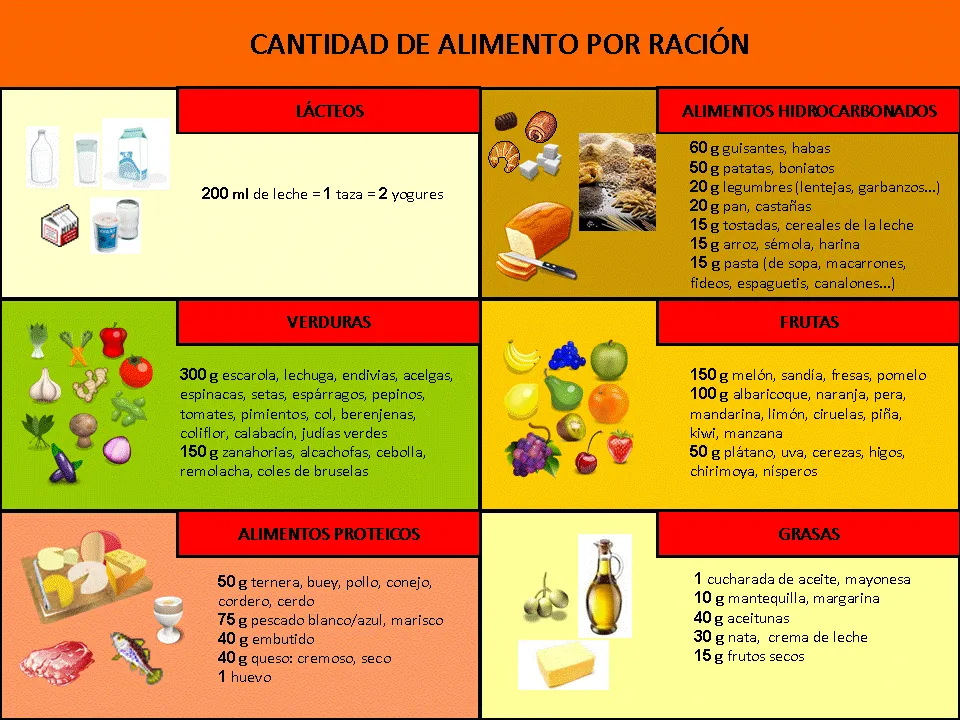The grace of the diet by rations is that you put the dose of insulin depending on the rations of carbohydrates that you are going to eat, more eate or commas less rations (within some logical margins) depends more on you, on you, on whatThat you want, if you are diet, if you are going to exercise, ect.
The important thing for diet by portions is:
1) Know the dose of insulin that you should wear for each ration of carbohydrates, for example, in my case it is 1 dose of insulin per 1 ration of carbohydrate, more or less (an HC ration is 10 grams of HC)
2) Know your insulin sensitivity throughout the day, that is, putting myself again as an example, my insulin sensitivity is higher at noon (because I get slowly in the morning and at noon it is already taking effect), this means that at noon my dose and ration ratio is 1/1 (as I have put up) but nevertheless at breakfast time and dinner is 2/1 (two doses of insulin for each ration) this isKnow a bit with practice, now that I have changed Lantus to Tresiba for example Esoty in 1.5/1
-------------------
The second part, also very important is to know food with HC and their glycemic indices (how fast the sugar goes up)
That is, the tacita is very good, but it is not the same this cup full of rice, which fills with macaroni, what you need is a swinging to weigh food and depending on what food weighs knowing how much HCeach one has
So a boat I will tell you soon:
100 grams of dry pasta is usually an average of 60 carbohydrates (6 rations of HC)
Those 100 grams of dry pass are usually converted into 300 of cooked pasta, that is:
100 grams of cooked pasta is usually an amedy of 20 carbohydrates (2 rations of HC)
The rice is more or less similar (look the food labels, there puts it to you, and it always puts its nutritional value as packaged, that is, the rice, the pasta, the lentil, ect if it puts it in thelabel is the weight of what is inside the label, not cooked)
Dry rice = I think it was per 80 HC per 100 grams (8 units)
boiled rice = 30 HC per 100 grams
*With the rice you have to be careful because it has a lot of starch and the sugar according to the person you do not see
In food like this I do is take small amount so that the lag is not so big
With potatoes, leggust and others is to follow the same process, look at ingredients and calculate
A page that I use a lot for when I need to know something about this is Link It is great, it also has an app for the mobile that allows you to make your diet and add food to see how much you are consuming
Before I have talked about the glycemic index and this is also very important, it does not rise the equal sugar 3 rations of rice carbohydrates that 3 rations of carbohydrates of beans of beans
Legumes such as beans, lentils and chickpeas are low(6 portions) and you have 80 sugar and you put the insulin before eating you can find the scare of having a quite severe hypo even despite having eaten, in these cases, if you eat legumes I would recommend putting the insulin afterEating, to avoid this type of scare (I have had them)
Finally, the bread has half of its weight in portions, that is, if you eat 100 grams of bread, there are 5 rations of HC
--------------------------------
Finally there are fats, fats do not immediately affect the level of sugar perse, but in combination with copious meals with HC they can modify the accounts, causing hydrates toThey absorb worse or you raise the sugar more from the account once the high effect of rapid insulin has passed.My first opinion would be that fatty things like sauces and others is to avoid them as much) And get to the idea that it is possible that after 2 hours of food you have to put insulin again to correct a possible climb
As I said this I have put is what I apply to my person, each person in this is a world, and experimentation and practice is what will make your balance
By the way, these types of diets that have given you, in my opinion are not worth at all, are diets that are usually given to people to lose weight and that are not really diabetic diets, the best thing is that you see that you eat,How healthy and that accounts of carbohydrates, I will put an axplo of meals that I do and how I do them:
Breakfast:
I usually eat a bowl of oatmeal, with milk, nuts and cinnamon and I do it like this:
40 grams of oat flakes (2 rations of HC)
200 ml of milk (1 HC ration)
A handful of nuts (about 10 grams)
cinnamon
Estevia
The sum of the total is about 3 rations of HC, as it is in the morning and I just put the slow one, I know that my insulin sensitivity is approximately 2/1, so I put 6 units of rapid
Meal:
300 grams of macarrones (6 HC rations)
A little tomato (it has HC but it is despicable unless you take a lot)
Some chicken (chicken is protein)
6 rations from HC at noon = 6 insulin units
Dinner:
A bowl of iceberg salad (200 grams) (HC 5)
A taquito of cool cheese
a can of tuna (and the oil of this to dress the salad)
2 pipe sticks (for putting some HC and "substance") (1 HC)
That is almost 2 HC, as at night my sensitivity is less because I get 4 doses
This is just three examples, how many HC should you eat?It depends on your exercise level, on your weight, if you are diet or not, the important thing is to adapt the dose and eat healthy in the proportion of carbohydrates/proteins/fatty/necessary
In principle I know it is very mess but the truth is that eating by HC is much more flexible than setting fixed units and lets you play much more.
I hope helped you
All the best





